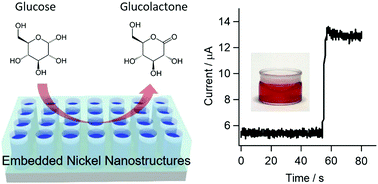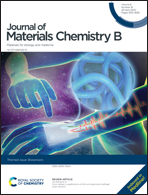Electrodeposition of nickel nanostructures using silica nanochannels as confinement for low-fouling enzyme-free glucose detection†
Abstract
This work reports an enzyme-free glucose sensor based on nickel nanostructures electrodeposited on a fluorine-doped tin oxide (FTO) electrode modified with a silica nanochannel membrane (SNM). The SNM consists of a high density of nanochannels vertically oriented to the electrode surface, which can spatially confine the electrodeposition of nickel nanostructures and protect them to make Ni@SNM/FTO electrodes. In alkaline media, nickel could be converted to nickel oxyhydroxide that displayed catalytic activity toward the anodic oxidation of glucose. The electrodes could thus function as enzyme-free sensors for glucose detection. Under optimal conditions, the sensors exhibited an excellent analytical performance, with an analytical sensitivity as high as 62.3 μA mM−1 cm−2, a wide detection range from 10 μM to 12 mM and a low detection limit of 0.44 μM. Furthermore, given nickel nanostructures were embedded inside the nanochannels of the SNM (with a diameter of 2–3 nm), the sensor possessed anti-fouling ability and outstanding current stability, thus allowing the direct detection of glucose in dilute blood samples.

- This article is part of the themed collection: Biosensors


 Please wait while we load your content...
Please wait while we load your content...